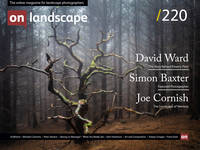The story behind Poverty Flats

David Ward
T-shirt winning landscape photographer, one time carpenter, full-time workshop leader and occasional author who does all his own decorating.
In prehistory – you know, 20 years ago before a gazillion images were uploaded on to the Net each day – photographers found out about new locations by hearsay, reading about them or (on very rare occasions) seeing an image in a book. In those days we usually had little idea of what we would find before we arrived. At the time it seemed frustrating but in retrospect being free of the burden of expectation actually looks like a wonderful blessing. On the few occasions where I have set out to photograph a famous spot, I have almost always been disappointed with the results. In fact the image that I am perhaps best known for was one that I stumbled upon following a series of unfortunate events.
Starting in the 1980’s and on into the 1990’s, the American photographer Michael Fatali made a number of 10x8 images in a place called Coyote Buttes, in the Paria Vermilion Cliffs Wilderness, Arizona. He gave each photo a poetic title, such as Tales of Time, Vertigo or The Wave. He was careful not to say where each photograph had been made. Fatali was not the first to photograph there and others – notably Jack Dykinga – have made equally stunning images. I don’t know if Fatali coined the name The Wave but it has become a landscape icon in the internet era. It has even achieved the ultimate accolade of becoming desktop wallpaper for Microsoft Windows™ computers. (yeah, right…)
Nowadays, this region is rightly considered one of the desert southwest’s most amazing locations for landscape photography. Ancient sand dunes, subsumed within the Earth’s crust, have been fossilised by millions of tons of pressure over millions of years. Millions more years of uplift and subsequent erosion by wind (and a little rain) have stripped away the overburden to reveal beautiful swirls of pink, yellow and cream Navajo sandstone. What’s not to like? Well, access isn’t straightforward.
First of all, visiting Coyote Buttes is dependent on acquiring a permit. The Paria Vermilion Cliffs Wilderness is split into a number of permit areas. Coyote Buttes is itself split into north and south. Only twenty are issued for each area per day. In those days, ten were issued for the next day from the Bureau of Land Management (BLM) Ranger Station nearby. The other half were available over the Internet a year in advance. Whilst researching how to get permits, Phil found out that they normally went within a few minutes of being released so he sat with finger poised over his mouse to claim four permits for Coyote Buttes North (CBN) for three consecutive days. I doubt that would be possible today as the popularity of the area has increased enormously since 2009 (the year when Microsoft used it on millions of machines for Windows 7). In 2018 there were 168,317 applicants for permits, with only 7,300 people allowed access per annum. That’s a 4.3% success rate. The pressure for permits was nowhere near so high in 2001 but we still needed Phil’s diligence. Thank you, Phil!

